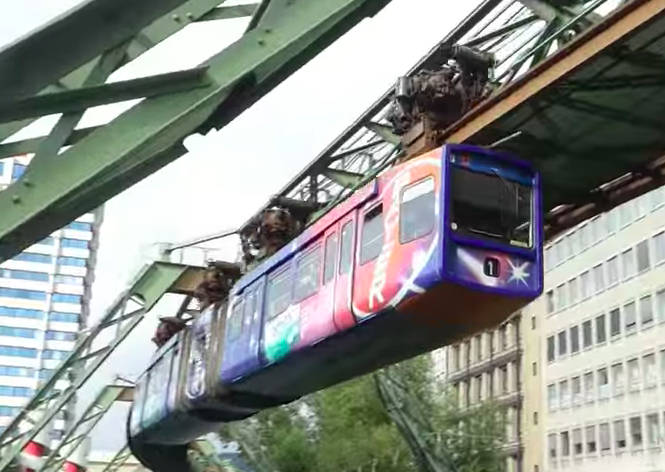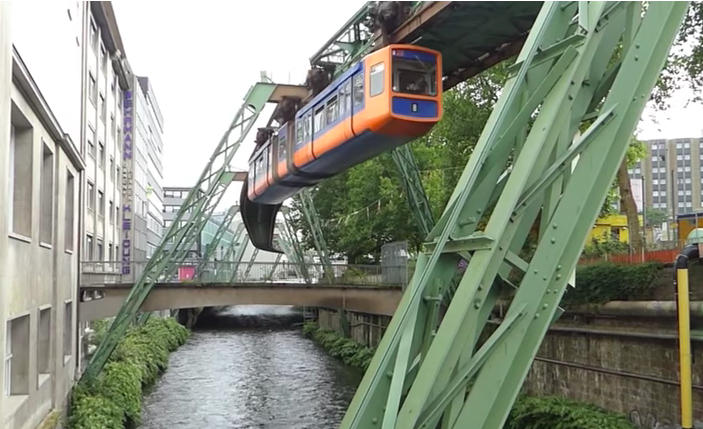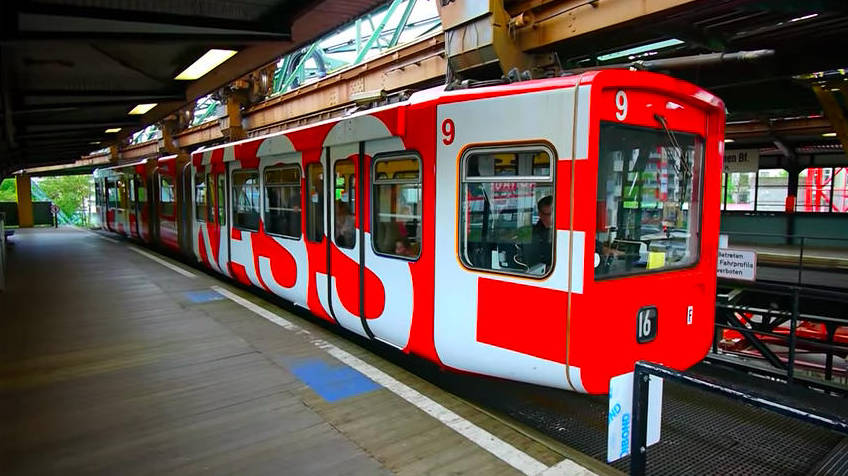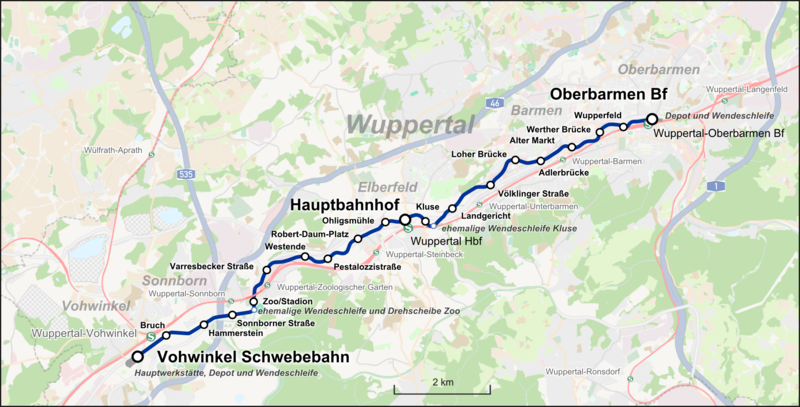The Wuppertal system of transportation is known as the Schwebebahn, and it is an elevated metro. It transits at a height of 12 meters, travels a distance of 13 kilometers, and offers service to 20 stations. The price of a regular ride on this system is of 2.70 euros. It works from 5:30 am until 11:00 pm. The frequency varies depending of the hour and the day of the week, ranging between four and 10 minutes.
Metros in Germany: Wuppertal Metro
The city
Wuppertal is a quite young city located in Germany. It was founded on the year 1929, being incorporated to the federal state of North Rhine-Westphalia. Like most German cities, Wuppertal is distinguished by its beauty. It is considered one of the greenest cities in the country since it has a diversity of parks and forests that make it a pleasant and touristic place.
Up until the year 2015, its population did not exceed 350,000 inhabitants, therefore, it can be inferred that it is a relatively small city.
The “Wupper Valley”, as it is also known, is currently one of the most important cities in Germany since a great variety of factories are located within it. Some of the available factories are from the following sectors: textile, metallurgic, chemical products and pharmaceutics, electronic products, cars, among others.
However, it is important to remember that Wuppertal also went through hard times during World War II since, due to the strong attacks and bombings that it received, at least 40% of its buildings and other infrastructures were damaged or destroyed.
The Schwebebahn (The Wuppertal Metro)
Without a doubt, one of the biggest attractions of the city, and the reason why people talks about this city, is its elevated metro. This means of transportation, which has the name Schwebebahn, is one of the most famous railway systems in the world thanks to its extraordinary technology.
Its construction began on the year 1898, being inaugurated three years later, on 1901, with a single line and 20 stations. It still has only one line.
It travels approximately 13.3 km at a height of 12 meters in a period of approximately 35 minutes. The journey on the Wuppertal Metro turns out to be pretty pleasant.

Lines and stations
The Wuppertal Metro only has a single line, which is comprised of 20 stations and covers the entire Vohwinkel-Oberbarmen region.
Stations
There are approximately 700 meters of distance between each station. Four of these belong to the surface-level route while the rest are elevated, being suspended statically through a scaffolding system. You can reach them through stairways. Also, an innovative system of elevators has been added to most stations, making it even easier to reach the stations.
Almost all of the Wuppertal Metro stops have had their original names changed. For instance, the station currently known as Ohligsmühleantes used to be called Alexander Brücke, and Kluse station was previously known as Bembergstraße. The most crowded stations are Hauptbahnhof and Zoo, therefore, both have special escalators that make the commute of passengers go a little faster. Some of the most important stations are:
Wuppertal Metro Video- Vohwinkel: the Vohwinkel station is both a station and a warehouse located on the western end of the line, which is where trains are stored, regardless whether the trains are arriving or departing the station. One hundred meters towards the east, the Wuppertal-Vohwinkel stop is built.
- Bruch (Untervohwinkel): This station shares the same characteristics in regards of construction and design with the stations Hammerstein and Sonnborn. The Bruch station is built on the street, in the middle of two rows of houses. And, just like many other stations, it has wide escalators and new elevators due to renovations.
- Hammerstein: The Hammerstein station belongs to the group of three stations that were planned to be built on the same way (Bruch and Sonnborn,) therefore, it was also built at surface level, in the middle of rows of houses. This stop is located to the west of Vohwinkel.
- Sonnborn: This is the fourth Wuppertal metro station, and it is important because it is a connection and/or transfer point with the Dusseldorf-Elberfeld train. This allows the users to visit the district of Dusseldorf.
- Zoo/Estadio: It is located in the Sonnborn district of the city of Wuppertal, and was rebuilt after its demolition. It is a relevant station since it is near the sports facility of the city and the zoo.
- Varresbecker: In this station, the trains that go from the Bayer Plant to the west can be boarded. These trains connect the districts of Varresbecker and Kiesberg.
- Westend: The Westend station is located very near the Varresbecker station. The trains that transit by this stop go from the Bayer Factory to the east of Wuppertal.
- Pestalozzi Street: the bridge over the Wupper River is located near this stop, which was built to avoid traffic, as well as decreasing it in this region.
- Robert-Daum-Platz: This station is a transfer point for vehicles heading towards two directions. In this station, buses can be boarded to go towards the west, transiting through the Wupper River route. Likewise, other buses can be boarded that go towards the east of Wuppertal.
- Ohligsmülhe: the Ohligsmülhe station is located to the west of the Elberfelder Center, and it stands out since it is the main stop in Wuppertal. The reason for this is that it substituted the bus station that was previously located at the Wuppertal Central Station.
- Wuppertal Central Station: It is the station with the highest influx of passengers. It has one of the most beautiful designs for a station since it was built shaped like a house. In fact, it is called the “Köbo House.” It is noteworthy that, unlike other stations, this building is not only a station, but also a commercial building.
- Kluse: After being attacked during World War II, this station was completely burned down and subsequently closed down. It was not until the year 1999 that it was reopened.
- District Tribunal: This stop was rebuilt and reinaugurated in June, 2011. Within a short distance from it, the tribunals, the Berufskolleg, and the University of Wuppertal can be found.
- Völklinger Street: The station is located at the Berman district. This station allows the user to reach the employment office and the headquarters of the Wuppertal police. This stop was restored in the first half of 2011, but the original design was kept.
- Loher Bridge: The Loher Bridge stop is located on the Barmen district, and it is commonly known with the nickname of “the Junior College” since it is located right to the side of the University of Junior Wuppertal.
- Eagle: This station was also renovated since it was previously demolished. From it, the user can access the Opera House, as well as regions such as Lot, Rott, and Kothen.
- Alter Markt: This station is located between the Barmen pedestrian crossing and the City Hall. Just like all stations, this one was also rebuilt after World War II.
- Werther Bridge: The users describe it as one of the most beautiful stops of the metro. It was inspired and decorated with Art Nouveau elements. This station is located in the Bermen district.
- Wupperfeld Bridge: This station covers the western route of the city. From this station, the Wupperfeld Old Church can be accessed.
- Oberbarmen BF: It is the eastern terminal station. Outside of it, an important bus network offers its services.

Prices, tickets, and fares
The ticket for a single ride on the Wuppertal Metro has a quite accessible price: adults have to pay 2.70 euros, while children only have to pay 1.60 euros.
• Tages Ticket (Day Ticket): This ticket is valid for one or more people, and works for a bus ride, as well as a ride on the Wuppertal Metro. Given that this ticket is valid for an entire day, it is ideal for passengers that want to go to many destinations within a period of 12 hours, as well as for people who want to sightsee on the city. At the ticket booth, when you are about to get your ticket, you need to choose how many people will travel with you. Children are exempt from paying for their journey. The prices are the following:
- One person: 6.80 euros.
- Two people: 10 euros.
- Three people: 13.20 euros.
- Four people: 16.40 euros.
- Five people: 19.60 euros.
Kombi Ticket Zoo: By acquiring this ticket, the users have access to two different services at the same time: it works both as a means to travel on the Wuppertal Metro and as a means to visit the Wuppertal Zoo’s facilities.
The price for the Kombi Ticket Zoo is 14.5 euros for adults, 7 euros for children, and 28.5 euros for a small group of an adult and three children. For a group of two adults and three children, the ticket costs 37 euros.
Schedule, calendar, and timetables
The Wuppertal Metro offers service from 5:30 am until 11:00 pm . Therefore, if you were thinking of boarding one of the trains of the system after those hours, you will have to reconsider and look for an alternative.
The trains tend to arrive at the stops with a frequency between 8 and 10 minutes, although it decreases to only four minutes during the peak hours in the morning and the afternoon during weekdays. Likewise, the train frequency is also shorter during peak hours than on off peak hours during Saturdays. Even though the waiting times between each train during peak hours are not as short during Saturdays than on weekdays, they are still considerably shorter, since they change from 8 to 10 minutes during off peak hours to six minutes during peak hours. Meanwhile, the train frequency does not change during peak hours on Sundays since it remains the same all day long. The train frequency during Sundays is between 8 and 10 minutes.
Historical fun facts
The idea of a new transportation system appeared due to the industrialization of Wuppertal towards the end of the 19th century. The number of inhabitants during that time was of around 400,000 people. Also, there was a relative economic stability, therefore, people began to acquire vehicles and other related things. In this sense, the city’s traffic increased way too much, and there was not enough room for cars and pedestrians. A new transportation service was needed to alleviate the traffic on the roads.
Since Wupper was comprised of regions that had never been residential areas, there had been no need to create systems of urban transportation with convenient and accessible roads. This is a contrast of regions such as Elberfeld and Barmen, which had been always progressive cities that already had state of the art technology.
Another of the reasons why it was considered necessary the construction of a new system of transportation with state-of-the-art technology is that most firms and factories were located around the Wupper River, which made it easier to obtain funds to build a system of transportation around the river.
However, due to the geological conditions of the area, it was not possible to build an underground metro, since the surface was too rocky and was covered by water. Therefore, the idea of making an underground railway was discarded.
Much later, on the year 1898, after many periods of research and analysis, the construction of an elevated railway for the city of Wuppertal was approved and got a patent.
Monorail system
The Wuppertal Metro system works as a suspended monorail. In other words, the rail is attached to the trains’ roofs via wheels powered by different electric engines. These engines receive their electricity from an extra rail.

Technology
The Wuppertal Metro has 33 trains, which have been available to the users since the year 2011. These rail cars are 24 meters long and have four doors. Up to 48 users sitting down and 138 users standing up can be inside them. These trains reach a maximum speed of 60 km per hour, and have an average speed of 27 km per hour.
The Kaiserwagen train, the rail car used by the German emperor in the year 1900 during a test drive, is still operational (with some light modifications though,) and it currently offers scheduled tour services, ecclesiastical ceremonies, among other celebrations.
Modernization
After the attacks that the city received between the years 1943 and 1945, it was necessary to restore many stations (some of them were severely damaged.) It was even necessary to completely demolish them in some cases to be able to build them again. This was the case of the Ohligsmühleantes and Kluse stations (two stations that caught fire.)
Currently, all of the Wuppertal Metro stops have been modernized. The construction firms have focused on expanding the stations’ internal design by including new entrances such as entrances for the easy access of people with disabilities. Likewise, the stations now have modern elevators, new escalators, and surveillance cameras that offer more safety to the passengers.
Train safety
A lot of attention has been given to the Wuppertal Metro system to make it one of the safest transportation services. All of the trains of the system have a safety system that protect the road against any crash or accident caused by any human error or during any situation in which the driver was unable to control the train. The system has the following mechanism: the driver will have to constantly push a pedal to indicate the unit to change its service. If the driver does not do this, the system assumes that the driver is in no conditions of driving, and the train would automatically stop. Thanks to the creating of this safety circuit, the Wuppertal Metro does not have the need of an assistant at the driver’s cabin. Also, all of the trains have radars that detect its current position, as well as acceleration sensors.
Connection to the airport
Wuppertal does not have its own airport. For this reason, to arrive to or depart from this city by plane, you will need to use the closest airport, the Düsseldorf Airport, which is located to the north of Düsseldorf and to the East of the Rhine River. Reaching it is not hard at all. However, it could take you up to one hour to reach it. This means that you should take the necessary precautions to arrive in time to avoid any problems with your flight.
By using the Wuppertal Metro, the user will need to walk approximately 500 meters (10 minutes) from Vohwinkel to the Wuppertal-Vohwinkel train station. Then, you will have to carefully disembark at Sonnborn station, where you will have to make a transfer to the central station of the Düsseldorf Metro. Once you board the metro towards this direction, you will arrive in approximately four minutes to the station at the Düsseldorf Airport. Once you reach the Düsseldorf Airport terminal, walk a short distance, and you will be inside the airport. If you just landed at the airport and want to get to Wuppertal, make the same trip but in reverse order.
Nearby attractions
Apparently, the entire journey in the Wuppertal Metro is a sight to behold, since not only you will be able to see the entire Wupper Valley from above the river by travelling on the elevated road, but also the trains as well as the stations have an impeccable artistic design. Additionally, the entire path between the regions of Vohkinwel and Oberbarmen –from end to end- offers sightseeing places that everyone should visit.
For instance, in the stations of Varresbecker and Westend, the user can visit the facilities of the famous Bayer factory, which also offers a historical tour that offers insight on the spirit of entrepreneurship and role of this firm on the industry as a whole.
Likewise, if you decide to visit the wonderful Wuppertal Zoo, you will only need to board the elevated metro to reach it directly. Also, you will be able to acquire a ticket that not only works on the metro, but also works as a ticket to enter the zoo.
The Elberfeld Center is also an ideal place to meet other people and for leisure, since all kinds of activities can be done in here, such as going shopping, visit the famous Von der Heydt Museum, or sit down to listen a concert at the Old City Hall. The user can reach it without much hassle and in a short period of time by travelling on the metro towards the Wuppertal Central Station.
Also, by visiting the Barmen station, the user will be able to known the sophisticated Opera House. Any inhabitant of the city of Wuppertal will say that there is no better way of getting to know the city and its beauty than by using the elevated railway.
The Kaiserwagen
The Kaiserwagen is an elevated railway above the Wupper River, which was planned as an additional attraction for the users. Its construction began on summer of 1898. Two years later, Wilhelm II and his wife were already testing it by travelling on it from Döppersberg to Vohwinkel. The wagon in which the late emperor and his wife was preserved for posterity, becoming nowadays –after being carefully restored- a beautiful and classic train that is operational for the Wuppertal Metro. The train can be rented for celebrations, unforgettable lunches or dreamlike nights, where the users “float” over the Wupper River.
Coffee break or abundant brunch
If you are planning a romantic lunch or a business lunch, the Kaiserwagen is ideal for this since floating over the river offers nothing less than a relaxing, enjoyable and pleasant environment. But that is not all. Even morning tours are offered on this train in which a historical team tells the users the anecdotes and fun facts of the city. The rent includes a journey of at least an hour and hostesses dressed in folkloric and emblematic dresses.
Weddings on the nostalgic Kaiserwagen
Would you believe that the Kaiserwagen could be your wedding carriage? Well, the train can be rented for two newly-weds on that very special day and be the floor where their love is consecrated.
A marriage on this classical train has to be a wonderful experience with an exceptional atmosphere. The service offers the users interested on living this experience to have their ceremony via the Wuppertal Register, having 61 seats available, as well as the driver and a train assistant that are available for the guests.
Metro map of Wuppertal
Map via upload.wikimedia.orgSee map full resolution. It may take a little bit to load.
Wuppertal Schwebebahn map
- Also Known As: Schwebebahn
- Passengers/Day 80000
- Fares: 2.5€, honour system
- 24h operation: No
- Air Conditioning: No
- Walk between platforms: No
- Driverless trains: No
- Screen Doors Platforms: No
- Average Speed: 26,6km/h
- Max. Speed: 60km/h
- Operator: Wuppertaler Stadtwerke (WSW)
- 2
- Wuppertal Metro Official Website
Help us
If you consider that the information we provide is wrong, not accurated, outdated, translation contains errors, and you would like to help us to improve the file...you can contact us here.
Feel free to contact us if you dont find the system you're looking for and we'll add it as soon as we can!
Thank you very much!







